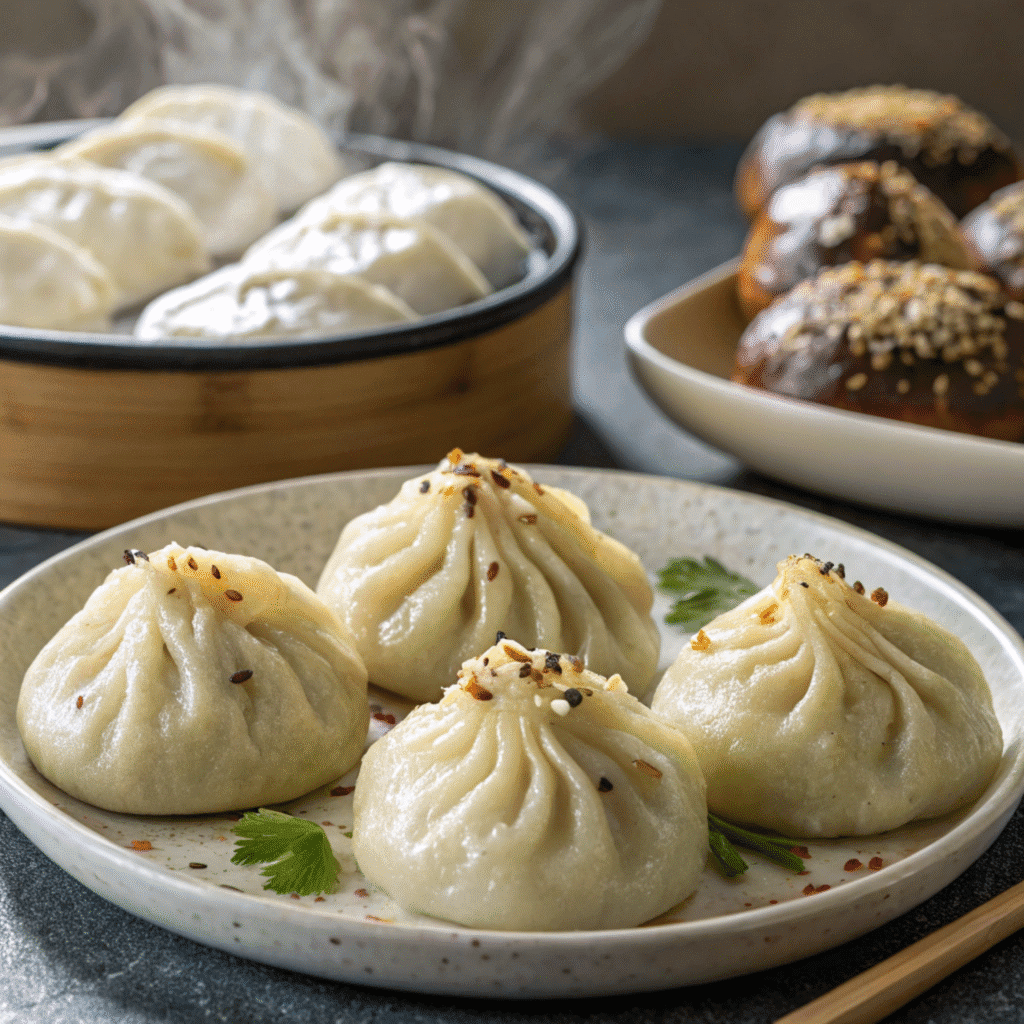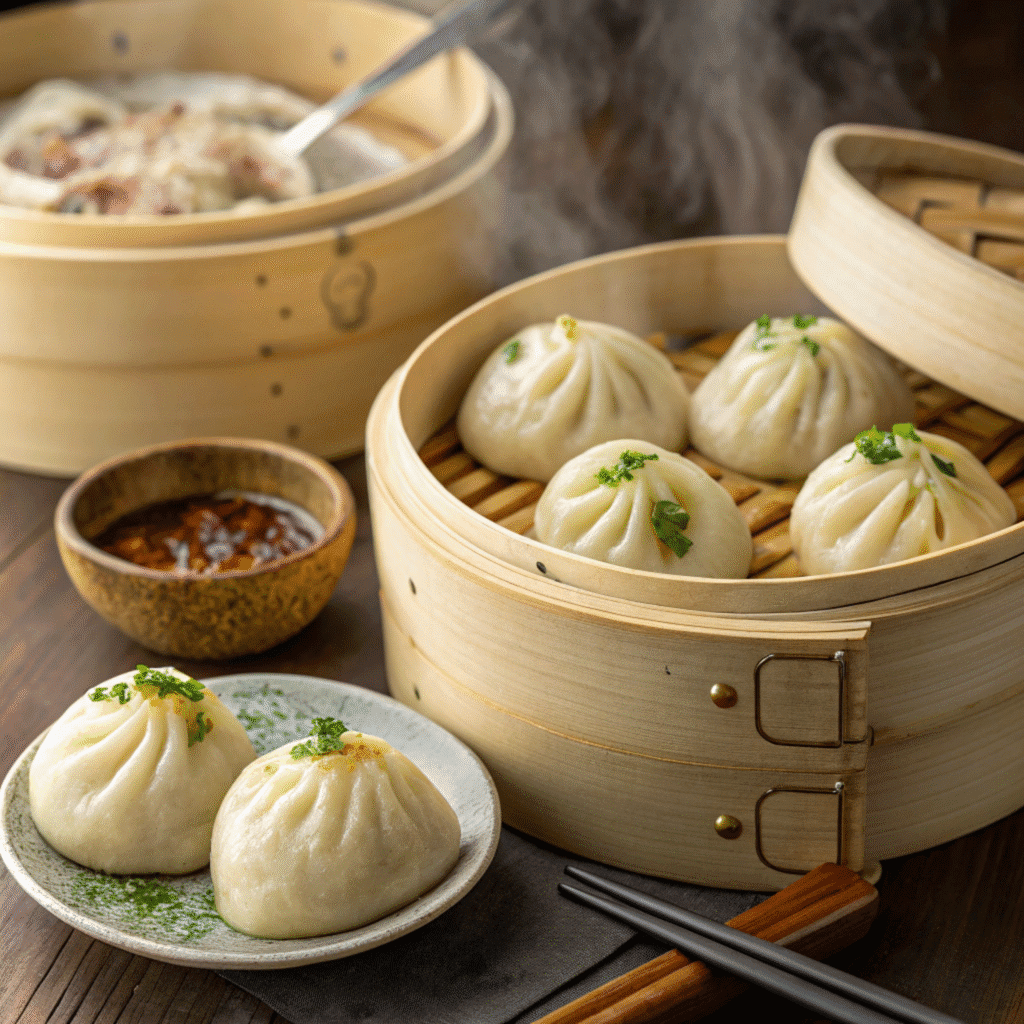
Dumpling steamed buns captivate food lovers worldwide with their soft, pillowy texture and flavorful fillings. These delightful morsels, often called baozi in Chinese cuisine, blend tradition, taste, and versatility. Whether you savor them at a bustling street market or craft them in your kitchen, dumpling steamed buns offer a culinary experience that’s both comforting and exciting. This comprehensive guide explores how to make dumpling steamed buns, their rich history, nutritional value, and tips to perfect this beloved dish.
What Are Dumpling Steamed Buns?
Dumpling steamed buns, commonly known as baozi or bao, are soft, fluffy buns filled with various ingredients like meats, vegetables, or a combination of both. Steamed to perfection, they boast a tender dough encasing a savory or sweet filling. Popular in Chinese cuisine, these buns appear in dim sum restaurants, street food stalls, and home kitchens across Asia and beyond. Their versatility allows for endless variations, from classic pork-filled baozi to vegetarian or even dessert-style buns.
Origins of Dumpling Steamed Buns
Dumpling steamed buns trace their roots to China, with a history spanning over a thousand years. Legend credits their creation to Zhuge Liang, a military strategist during the Three Kingdoms period (220–280 CE). According to folklore, Zhuge Liang invented baozi to resemble human heads as an offering to appease river spirits, replacing earlier sacrificial practices. While this tale adds intrigue, historical records suggest steamed buns evolved from earlier Chinese stuffed glutinous rice dumplings.
Baozi gained prominence during the Song Dynasty (960–1279 CE), becoming a staple in northern China. Over time, regional variations emerged, each with unique fillings and preparation methods. For example, Cantonese char siu bao features barbecue pork, while Shanghai’s soup-filled xiaolongbao showcases a delicate broth inside. Today, dumpling steamed buns appear in cuisines across Asia, including Japan (nikuman) and Korea (mandu), reflecting their widespread appeal.
Why Dumpling Steamed Buns Are So Popular
Dumpling steamed buns win hearts for several reasons. Their soft, cloud-like texture contrasts beautifully with savory or sweet fillings, creating a balanced bite. They’re portable, making them ideal for street food or quick meals. Additionally, their adaptability suits various dietary preferences, from meat-heavy fillings to vegan options. Whether enjoyed as a snack, breakfast, or main dish, dumpling steamed buns deliver satisfaction in every bite.
How to Make Dumpling Steamed Buns at Home
Making dumpling steamed buns at home is rewarding and surprisingly approachable. Below, we outline a step-by-step recipe for classic pork-filled baozi, with tips for success. This recipe yields about 12 buns and takes approximately 2.5 hours, including dough resting time.
Ingredients for Dumpling Steamed Buns
Dough:
- 3 cups all-purpose flour
- 1 cup warm water (about 110°F)
- 2 teaspoons active dry yeast
- 2 tablespoons sugar
- 1 tablespoon vegetable oil
- 1 teaspoon baking powder
- 1/2 teaspoon salt
Filling:
- 1 pound ground pork
- 1 cup finely chopped cabbage
- 2 tablespoons soy sauce
- 1 tablespoon sesame oil
- 1 tablespoon grated ginger
- 2 cloves garlic, minced
- 2 green onions, finely chopped
- 1 tablespoon rice wine or dry sherry
- 1 teaspoon sugar
- 1/2 teaspoon white pepper
- Salt to taste
Equipment:
- Steamer (bamboo or metal)
- Parchment paper or cabbage leaves
- Mixing bowls
- Rolling pin
Step-by-Step Instructions
1. Prepare the Dough
Activate the yeast by combining warm water, sugar, and yeast in a small bowl. Let it sit for 5–10 minutes until foamy. In a large mixing bowl, combine flour, baking powder, and salt. Add the yeast mixture and vegetable oil. Mix until a dough forms. Knead on a floured surface for 8–10 minutes until smooth and elastic. Place the dough in a lightly oiled bowl, cover with a damp cloth, and let it rise in a warm place for 1–1.5 hours until doubled in size.
2. Make the Filling
While the dough rises, prepare the filling. In a large bowl, mix ground pork, cabbage, soy sauce, sesame oil, ginger, garlic, green onions, rice wine, sugar, white pepper, and a pinch of salt. Stir until well combined. Cover and refrigerate until ready to use.
3. Shape the Buns
Punch down the risen dough and divide it into 12 equal pieces. Roll each piece into a ball. On a lightly floured surface, roll each ball into a 4-inch circle, keeping the center slightly thicker than the edges. Place 1–2 tablespoons of filling in the center of each circle. Gather the edges of the dough, pinching and twisting to seal the bun. Ensure a tight seal to prevent leakage during steaming.
4. Steam the Buns
Line a steamer basket with parchment paper or cabbage leaves to prevent sticking. Place the buns seam-side down in the steamer, leaving space between each to allow for expansion. Cover and let the buns rest for 15–20 minutes. Bring water to a boil in a wok or large pot, then place the steamer basket over it. Steam the buns for 15–18 minutes until puffed and cooked through.
5. Serve and Enjoy
Remove the buns from the steamer and let them cool slightly. Serve warm with dipping sauces like soy sauce, chili oil, or black vinegar with ginger slivers. Enjoy your homemade dumpling steamed buns fresh for the best flavor.

Tips for Perfect Dumpling Steamed Buns
- Knead Thoroughly: A smooth, elastic dough ensures fluffy buns.
- Seal Tightly: Prevent filling from leaking by pinching the dough firmly.
- Don’t Overfill: Too much filling can cause buns to burst during steaming.
- Steam Properly: Ensure the water is boiling before placing the steamer to achieve the right texture.
- Experiment with Fillings: Try shrimp, chicken, mushrooms, or tofu for variety.
Variations of Dumpling Steamed Buns
Dumpling steamed buns adapt to diverse tastes and dietary needs. Here are popular variations to explore:
- Char Siu Bao: Filled with sweet and savory barbecue pork, a Cantonese favorite.
- Vegetarian Baozi: Packed with mushrooms, tofu, carrots, and water chestnuts.
- Xiaolongbao: Soup-filled buns with a delicate dough, requiring extra care to seal.
- Sweet Buns: Filled with red bean paste or custard for a dessert twist.
- Spicy Beef Bao: Infused with chili oil and Sichuan peppercorns for a bold kick.
Nutritional Value of Dumpling Steamed Buns
Dumpling steamed buns offer a balanced nutritional profile, depending on the filling and portion size. Below is an approximate nutritional breakdown for one pork-filled baozi (about 100g):
- Calories: 200–250 kcal
- Protein: 10–12g
- Fat: 8–10g
- Carbohydrates: 25–30g
- Fiber: 1–2g
- Sodium: 400–600mg
Health Benefits
- Protein-Rich: Pork or other meat fillings provide essential amino acids for muscle repair and growth.
- Low in Fat (When Steamed): Steaming avoids added oils, making buns lighter than fried dumplings.
- Vegetable Boost: Fillings with cabbage, mushrooms, or other vegetables add fiber, vitamins, and minerals.
- Customizable: Vegetarian or low-sodium fillings cater to specific dietary needs.
Considerations
- Sodium Content: Soy sauce and seasoned fillings can increase sodium levels, so moderation is key for those watching salt intake.
- Calorie Density: Overfilling with fatty meats can raise calorie counts, so balance with vegetable-heavy fillings.
- Gluten: The dough contains wheat flour, making it unsuitable for gluten-free diets unless adapted with alternative flours.
For a healthier twist, opt for whole wheat flour in the dough or increase vegetable content in the filling. Always adjust ingredients to align with your dietary goals.
Cultural Significance of Dumpling Steamed Buns
Dumpling steamed buns hold deep cultural significance in Chinese cuisine and beyond. They often appear during festivals, family gatherings, and celebrations like Lunar New Year, symbolizing prosperity and unity. In northern China, baozi serves as a hearty breakfast or snack, while in southern regions, it’s a dim sum staple. Their portability and affordability make them a beloved street food, fostering community connections at bustling markets.
Globally, dumpling steamed buns have transcended cultural boundaries. They appear in Asian fusion restaurants, food trucks, and home kitchens, reflecting their universal appeal. Chefs and home cooks experiment with innovative fillings, blending traditional techniques with modern flavors.
Storing and Reheating Dumpling Steamed Buns
To enjoy dumpling steamed buns later, store them properly:
- Refrigeration: Place cooled buns in an airtight container and refrigerate for up to 3 days.
- Freezing: Freeze uncooked or cooked buns on a tray, then transfer to a freezer bag. They last up to 3 months.
- Reheating: Re-steam refrigerated or frozen buns for 5–10 minutes until heated through. Microwaving works but may alter texture.
Pairing Dumpling Steamed Buns
Enhance your dumpling steamed buns with these pairings:
- Dipping Sauces: Soy sauce with ginger, chili oil, or hoisin sauce adds depth.
- Sides: Serve with pickled vegetables, cucumber salad, or hot and sour soup for a complete meal.
- Beverages: Pair with green tea, jasmine tea, or a light beer to complement the flavors.
Common Mistakes to Avoid
Avoid these pitfalls when making dumpling steamed buns:
- Overproofing the Dough: Letting the dough rise too long can lead to overly airy buns that collapse.
- Underfilling: Skimping on filling results in bland buns with too much dough.
- Improper Steaming: Low heat or overcrowding the steamer can yield soggy or unevenly cooked buns.
- Skipping Resting Time: Allowing the shaped buns to rest before steaming ensures a fluffy texture.
Where to Find Dumpling Steamed Buns
Craving dumpling steamed buns but not ready to make them? Visit:
- Dim Sum Restaurants: Authentic spots in Chinatowns or Asian neighborhoods serve fresh baozi.
- Street Food Markets: Vendors in cities like Hong Kong, Taipei, or New York offer grab-and-go buns.
- Grocery Stores: Frozen baozi are available in Asian markets or major supermarkets for quick home steaming.
Fun Facts About Dumpling Steamed Buns
- Baozi inspired the name of Disney’s animated short “Bao,” which explores family and cultural identity.
- In China, some regions shape buns differently to indicate specific fillings, like triangular buns for vegetarian options.
- Steamed buns are a breakfast staple in northern China, often paired with congee or soy milk.
Dumpling steamed buns combine tradition, flavor, and creativity in every bite. From their ancient Chinese origins to their modern global popularity, these buns offer endless possibilities for home cooks and food enthusiasts. With our detailed recipe, you can craft fluffy, delicious baozi in your kitchen. Their nutritional balance and cultural significance make them more than just a meal—they’re a celebration of culinary heritage. Grab your steamer, gather your ingredients, and start making your own dumpling steamed buns today!

